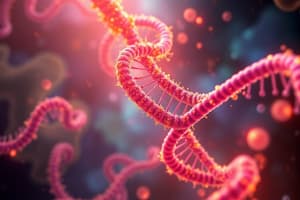Podcast
Questions and Answers
What are the two general categories of point mutations within a gene?
What are the two general categories of point mutations within a gene?
- Nonsense mutations and frame-shift mutations
- Single nucleotide-pair substitutions and nucleotide-pair insertions or deletions (correct)
- Silent mutations and missense mutations
- Insertion mutations and substitution mutations
What will most nonsense mutations lead to?
What will most nonsense mutations lead to?
- The production of an abnormal protein
- An increase in the number of amino acids
- A normal protein
- A nonfunctional protein (correct)
Which type of mutation does not affect the amino acid produced by a codon?
Which type of mutation does not affect the amino acid produced by a codon?
- Nonsense mutation
- Silent mutation (correct)
- Deletion mutation
- Missense mutation
What can spontaneous mutations occur as a result of?
What can spontaneous mutations occur as a result of?
What is the change that occurs in a missense mutation?
What is the change that occurs in a missense mutation?
What is the flow of genetic information from DNA to protein primarily guided by?
What is the flow of genetic information from DNA to protein primarily guided by?
During transcription, what is the role of RNA polymerase?
During transcription, what is the role of RNA polymerase?
Which stage of transcription involves the assembly of transcription factors and RNA polymerase at the promoter?
Which stage of transcription involves the assembly of transcription factors and RNA polymerase at the promoter?
In eukaryotes, what separates transcription from translation?
In eukaryotes, what separates transcription from translation?
How does the genetic code ensure accurate translation of mRNA into protein?
How does the genetic code ensure accurate translation of mRNA into protein?
What is the role of tRNA in translation?
What is the role of tRNA in translation?
What is a primary transcript in eukaryotes?
What is a primary transcript in eukaryotes?
Which of the following describes the non-template strand of DNA during transcription?
Which of the following describes the non-template strand of DNA during transcription?
Which type of mutation can have adverse effects on an organism's phenotype?
Which type of mutation can have adverse effects on an organism's phenotype?
What are the three stages of translation?
What are the three stages of translation?
What initiates the process of RNA synthesis during transcription?
What initiates the process of RNA synthesis during transcription?
What occurs during the termination stage of transcription in prokaryotes?
What occurs during the termination stage of transcription in prokaryotes?
Which sequence of events accurately describes the central dogma of molecular biology?
Which sequence of events accurately describes the central dogma of molecular biology?
Which ribosomal site holds the tRNA that carries the growing polypeptide chain?
Which ribosomal site holds the tRNA that carries the growing polypeptide chain?
Flashcards
Mutation
Mutation
A permanent change in the nucleotide sequence of an organism's DNA. These changes can occur spontaneously during DNA replication, recombination, or repair.
Mutagens
Mutagens
Agents that can induce mutations in DNA, increasing the mutation rate.
Point mutation
Point mutation
Changes in a single nucleotide within a gene. These changes can have different effects on protein function.
Silent mutation
Silent mutation
Signup and view all the flashcards
Missense mutation
Missense mutation
Signup and view all the flashcards
Gene Expression
Gene Expression
Signup and view all the flashcards
Transcription
Transcription
Signup and view all the flashcards
Translation
Translation
Signup and view all the flashcards
Codon
Codon
Signup and view all the flashcards
Template Strand
Template Strand
Signup and view all the flashcards
Non-Template Strand
Non-Template Strand
Signup and view all the flashcards
RNA Polymerase
RNA Polymerase
Signup and view all the flashcards
Promoter
Promoter
Signup and view all the flashcards
Transcription Unit
Transcription Unit
Signup and view all the flashcards
Terminator
Terminator
Signup and view all the flashcards
Transcription Factors
Transcription Factors
Signup and view all the flashcards
Transcription Initiation Complex
Transcription Initiation Complex
Signup and view all the flashcards
Polyadenylation
Polyadenylation
Signup and view all the flashcards
Transfer RNA (tRNA)
Transfer RNA (tRNA)
Signup and view all the flashcards
Anticodon
Anticodon
Signup and view all the flashcards
Study Notes
BIOL 217 Topic 11: Gene Expression
- Gene expression is the process by which DNA directs protein synthesis, encompassing transcription and translation.
- DNA is inherited, leading to the expression of specific traits through protein synthesis.
- The information content of genes resides within the specific nucleotide sequences.
- Proteins link genotype to phenotype.
- The central dogma describes the flow of genetic information: DNA → RNA → Protein.
- RNA acts as a bridge between genes and the proteins they encode.
Learning Objectives
- Understand the central dogma, genetic code, and how genetic information flows from genes to proteins.
- Compare and contrast transcription and translation.
- Explain the steps in transcription (initiation, elongation, termination) and the key molecules involved.
- Understand different types of mutations and their impact on the translated protein.
Transcription
- Transcription is the first stage of gene expression, and it's DNA-directed RNA synthesis.
- RNA synthesis is catalyzed by RNA polymerase.
- Transcription comprises three stages: initiation, elongation, and termination.
- In prokaryotes, translation can begin before transcription is complete.
- In eukaryotes, the nuclear envelope separates transcription from translation.
- Eukaryotic RNA transcripts undergo RNA processing to form mature mRNA from a primary transcript.
Transcription and RNA Polymerase
- RNA polymerase synthesizes RNA strands by joining RNA nucleotides together in a 5' to 3' direction.
- RNA polymerase follows base-pairing rules, but uracil replaces thymine.
- RNA produced is complementary to the DNA template strand.
- Promoters are DNA sequences where RNA polymerase attaches.
- In bacteria, the sequence signaling the end of transcription is called a terminator.
- A transcription unit is the stretch of DNA that is transcribed.
Synthesizing an RNA transcript - Initiation
- Promoters are transcriptional start points, extending several dozen nucleotides upstream of the start point.
- The TATA box is crucial in forming the initiation complex in eukaryotes.
- Transcription factors mediate the binding of RNA polymerase and initiate transcription.
- The transcription initiation complex is the completed assembly of transcription factors and RNA polymerase II bound to a promoter.
Synthesizing an RNA transcript - Elongation
- As RNA polymerase moves along DNA, it unwinds the double helix, exposing 10-20 bases at a time.
- Transcription progresses at a rate of 40 nucleotides per second in eukaryotes.
- A gene can be transcribed simultaneously by several RNA polymerases.
- Nucleotides are added to the 3' end of the growing RNA molecule.
Synthesizing an RNA transcript - Termination
- The mechanisms of termination differ in bacteria and eukaryotes.
- In bacteria, RNA polymerase stops transcription at the end of the terminator sequence.
- In eukaryotes, RNA polymerase transcribes the polyadenylation signal sequence, releasing the RNA transcript 10–35 nucleotides past the sequence.
Translation
- Translation is the process where genetic information flows from mRNA to protein.
- Translation creates a polypeptide based on the mRNA information.
Molecular Components involved in translation
- Cells translate mRNA messages into protein using transfer RNA (tRNA).
- tRNAs carry specific amino acids to the ribosome, where they are attached to the growing polypeptide chain.
Transfer RNA (tRNA)
- Each tRNA molecule facilitates the translation of a specific mRNA codon into a particular amino acid.
- Each tRNA carries a specific amino acid and has an anticodon at the other end that base-pairs with a complementary codon on the mRNA.
- tRNA has a characteristic L-shape.
Accurate Translation Requires Two Major Steps
- A correct match between tRNA and amino acid is catalyzed by aminoacyl-tRNA synthetase.
- A correct match between tRNA anticodon and mRNA codon is essential.
Ribosomes
- Ribosomes facilitate mRNA codon-tRNA anticodon coupling, essential for protein synthesis.
- Ribosomes are composed of large and small ribosomal subunits, made of proteins and rRNA.
Ribosomal binding sites for tRNA
- Ribosomes possess three binding sites for tRNA: A site, P site, and E site.
- The A site accepts tRNA carrying the next amino acid.
- The P site holds tRNA carrying the growing polypeptide chain.
- The E site releases discharged tRNAs.
Building a polypeptide
- Translation involves three stages: initiation, elongation, and termination.
- Energy is required for some steps in translation, and factors aid each stage.
Mutations
- Mutations are changes in the genetic information of a cell.
- Mutations of one or a few nucleotides can affect protein structure and function, potentially leading to genetic disorders or hereditary diseases.
New Mutations and Mutagens
- Spontaneous mutations occur during DNA replication, recombination, or repair.
- Mutagens are physical or chemical agents that cause mutations.
DNA Mutations
- Point mutations involve changes in just one nucleotide pair in a gene.
- Point mutations can be nucleotide-pair substitutions or insertions/deletions, affecting the abnormal protein production.
- Nucleotide-pair substitutions can include silent mutations (no change in amino acid), missense mutations (change to a different amino acid), and nonsense mutations (change to a stop codon), potentially leading to nonfunctional proteins.
Studying That Suits You
Use AI to generate personalized quizzes and flashcards to suit your learning preferences.




